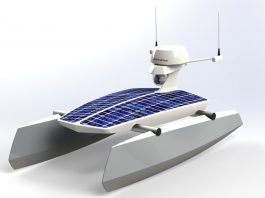The University of Southampton and University of Edinburgh, UK, have been inspired by jellyfish to engineer a flexible underwater robot that can propel itself through water.
As published in Science Robotics, the research team has demonstrated that the new underwater robot can swim as quickly and efficiently as the aquatic creatures that inspired its design. Its lightweight design and soft exterior has the potential to facilitate a new wave of underwater exploration.
Co-author Dr Francesco Giorgio-Serchi, Lecturer and Chancellor’s Fellow, at the School of Engineering, University of Edinburgh, said: “The fascination for organisms such as squid, jellyfish and octopuses has been growing enormously because they are quite unique in that their lack of supportive skeletal structure does not prevent them from outstanding feats of swimming.”
The new robot is the first submersible to demonstrate the benefits of using resonance for underwater propulsion, which refers to large vibrations that occur when applying a force at the ideal frequency. This allows the robot to use very little power but generate large water jets to push itself forward.
The robot’s mechanism consists of a rubber membrane enclosing eight 3D-printed flexible ribs, which form a ‘propulsive bell’. A small piston in the top half of the robot taps this bell repeatedly so that it expands and then springs back. This mimics a jellyfish’s swimming technique and produces the jets of fluid to propel the robot through the water. When the piston operates with the correct frequency the robot can move at one body length per second and match the efficiency of the Aurella aurita jellyfish.
Co-author Thierry Bujard, a master’s student of naval architecture at the University of Southampton, said: “Previous attempts to propel underwater robots with jetting systems have involved pushing water through a rigid tube but we wanted to take it further, so we brought in elasticity and resonance to mimic biology. I was really surprised by the results; I was confident that the design would work but the efficiency of the robot was much greater than I expected.”
The latest tests show the new robot is up to 50 times more efficient than typical small underwater vehicles powered by propellers. This increased efficiency, combined with the additional benefits of the robot’s soft, flexible exterior would make it ideal for operating near sensitive environments such as a coral reef, archaeological sites, or even in waters crowded with swimmers.









